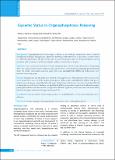Please use this identifier to cite or link to this item:
https://hdl.handle.net/20.500.14356/1719| Title: | Glycemic Status in Organophosphorus Poisoning |
| Authors: | Panda, S Nanda, R Mangaraj, M Rathod, K P Mishra, P K |
| Citation: | PandaS., NandaR., MangarajM., RathodK. P., & MishraP. K. (2016). Glycemic Status in Organophosphorus Poisoning. Journal of Nepal Health Research Council. https://doi.org/10.33314/jnhrc.v0i0.675 |
| Issue Date: | 2015 |
| Publisher: | Nepal Health Research Council |
| Article Type: | Original Article |
| Keywords: | Atropine Hyperglycemia Organophosphorus Oxidative stress Random plasma glucose |
| Series/Report no.: | Sep-Dec, 2015;675 |
| Abstract: | Abstract Background: Organophosphorus (OP) poisoning, in addition to its cholinergic manifestations shows metabolicderangements leading to hyperglycemia. Apart from inhibiting acetylcholinesterase it also induces oxidative stressto exhibit this manifestation. The present study aims to assess the glycemic status of OP poisoned patients and its association with various factors in OP poisoning like oxidative stress and dose of atropine. Methods: This is a prospective study which recruited 102 patients above 18 years of age with history of OP poisoning.They were categorized into 3 grades-mild, moderate and severe based on the Peradeniya Organophosphorus Poisining Scale. The routine biochemical parameters along with serum malondialdehyde (MDA) and cholinesterase were estimated in the study group. Results: Hyperglycemia and glycosuria were observed, with majority cases of hyperglycemia (57%) noticed in thesevere group. There was a rise in the random plasma glucose (RPG), serum malondialdehyde (MDA), total dose ofatropine across the groups along with a fall in the serum cholinesterase with increase in severity of poisoning. The fallin plasma glucose at the time of discharge was significant in all three groups when compared to the admission randomplasma glucose(RPG) level. This transient hyperglycemia exhibited a significant positive association with serum MDAand dose of atropine administered during treatment (p<0.05). Conclusions: Glycemic status in OP poisoning may play a role in identifying the severity of poisoning at the time ofadmission. |
| Description: | Original Article |
| URI: | http://103.69.126.140:8080/handle/20.500.14356/1719 |
| ISSN: | Print ISSN: 1727-5482; Online ISSN: 1999-6217 |
| Appears in Collections: | Vol. 13 No 3 Issue 31 Sep-Dec 2015 |
Files in This Item:
| File | Description | Size | Format | |
|---|---|---|---|---|
| 675-Article Text-1265-2-10-20160320.pdf | Full Text Article | 258.37 kB | Adobe PDF |  View/Open |
Items in DSpace are protected by copyright, with all rights reserved, unless otherwise indicated.
